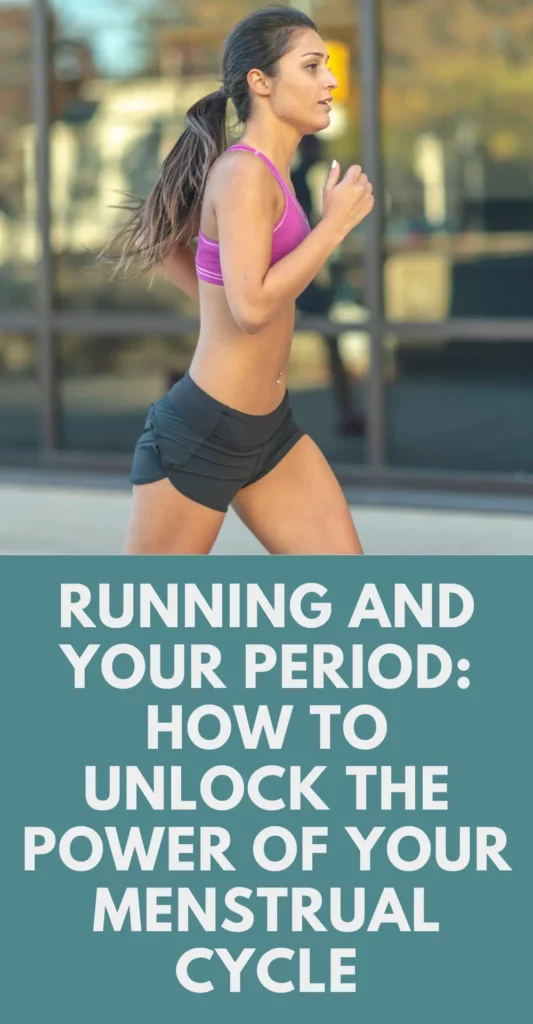Running and your period should not be overlooked.
You know the feeling – you start your period and the last thing you feel like doing is going for a run or doing an intense workout.
Your period doesn’t have to stop you in your tracks – you can still exercise – it’s just about adapting what you’re doing.
Understanding and managing your menstrual cycle is crucial for optimising performance and wellbeing.
Not only will you feel more empowered to tailor your training, you will be able to adapt your workouts to align with your body’s natural rhythm.
As a runner, you’ll know that there are highs and lows on your running journey.
The same applies during the menstrual cycle – so by improving your understanding of it – you will enhance your running experience.
Ultimately, working with your menstrual cycle (and not against it), is all about listening to your body and embracing its fluctuations.
Marathon world record holder Paula Radcliffe famously spoke out about how her menstrual cycle has affected her performance over the years.
She also said that “Sport has not learned about periods” – which I agree with!
Run with the flow of your cycle and you will have a more fulfilling running journey.
In this guide, we’ll look at each stage of the menstrual cycle, explore its impact on the body and provide tailored exercise recommendations for each stage.
We’ll also look at some common conditions that can affect your menstrual cycle.
Ready?
Let’s get going!

Running and your period: Understanding the menstrual cycle
The menstrual cycle is a natural process that happens in a woman’s body, typically lasting between 28 to 32 days.
It involves various stages and hormonal changes, and its main goal is to prepare the body for the possibility of pregnancy.
It consists of four key stages – starting with menstruation on day 1:
- Menstruation (Days 1-5)
- Follicular Phase (Days 6-14)
- Ovulation (Days 15-17)
- Luteal Phase (Days 18-28)
Let’s break these stages down into simple terms. We’ll look at what happens, the hormones involved and typical symptoms.
Menstruation (Days 1-5):
What happens: If there is no pregnancy, the uterus sheds its lining (blood and tissue), which comes out through the vagina.
Hormones involved: Estrogen and progesterone levels are low during this time.
Symptoms: Cramping, bloating, fatigue, mood swings, irritability.
Related: Does chocolate help with period cramps? Everything you need to know
Follicular Phase (Days 6-14):
What happens: The body prepares an egg for release. The lining of the uterus begins to thicken.
Hormones involved: Estrogen levels rise, stimulating the growth of the egg and the uterine lining.
Symptoms: Increased energy, improved mood, positive outlook, motivation.
Related: Should you work out on your period? 6 best exercises

Ovulation (Days 15-17):
What happens: The mature egg is released from the ovary into the fallopian tube, making it available for fertilisation.
Hormones involved: There’s a surge in luteinising hormone (LH), which triggers the release of the egg. Estrogen levels also peak.
Symptoms: Increased body temperature, possible mild pelvic pain, heightened senses, increased libido.
Related: Do you burn more calories on your period? Your common questions answered
Luteal Phase (Days 18-28):
What happens: If the egg isn’t fertilised, hormone levels drop. The uterine lining starts breaking down, preparing for the next menstrual cycle.
Hormones involved: Progesterone levels rise, maintaining the uterine lining. If no pregnancy occurs, both estrogen and progesterone levels eventually decrease.
Symptoms: Breast tenderness, bloating, fatigue, mood swings, irritability, increased sensitivity.
Related: When does period weight go away? All your questions answered

Running and your period: Recommended exercises at each stage of your menstrual cycle
Here are some recommended exercises for each stage of the menstrual cycle:
Menstruation (Days 1-5)
Hormone levels are relatively low during this phase and energy levels may be impacted.
So you may want to stick with light to moderate-intensity exercise like brisk walking, yoga and gentle stretching can be beneficial.
Light jogging is also an option if you want to continue running – just do what feels comfortable.
These activities help maintain mobility without overtaxing the body.
They also promote blood flow, alleviate cramps and provide a low impact way to stay active.
Related: Fuelling your run: A female runner’s guide to nutrition and running performance
Follicular Phase (Days 6-14)
As estrogen levels rise, you’ll likely have higher levels of energy during your follicular phase, making it a great time to do more intense training sessions.
This is an optimal time for activities like speed training, strength training and moderate-distance running.
Again, continue to listen to your body.
Embrace the surge of energy to push boundaries and build endurance.
Related: Running on a busy schedule: 10 tips for time-strapped women
Ovulation (Days 15-17)
Levels of estrogen and testosterone are at their peak during ovulation, making it a great time for endurance activities.
You may want to continue with intense workouts like high-intensity interval training (HIIT) or hill workouts to capitalise on the heightened energy levels.
Just remember to be attentive to the body’s signals and adjust the intensity accordingly.
Related: Running through the decades: What to expect in your 20s, 30s and 40s as a female runner
Luteal Phase (Days 18-28)
Progesterone levels rise during this phase, which may potentially lead to increased fatigue and muscle soreness.
Focus on maintaining a balance between activity and recovery during this phase.
Opt for activities like easy runs, cycling, swimming and flexibility exercises like yoga and Pilates.
Focusing on lower-intensity activities during the luteal phase will help to manage fatigue and support recovery and the body’s needs.
Related: Your step-by-step guide to create the perfect training plan

Running and your period: Conditions that can impact the menstrual cycle
It’s worth noting that several conditions can impact the menstrual cycle.
These can lead to irregularities or disruptions in the normal menstrual and hormonal processes.
It’s important to note that these conditions can vary in severity and their impact on the menstrual cycle may differ among individuals.
If you experience persistent irregularities, excessive pain or changes in your menstrual cycle, then it’s advisable to consult a healthcare professional for a thorough check-up.
Explain your symptoms in detail and always ask for a second opinion if you’re not getting the answers you need from your doctor.
Here are some common problems associated with the menstrual cycle:
Polycystic Ovary Syndrome (PCOS)
What is it? PCOS is a common hormonal disorder among women of reproductive age. It is characterised by the presence of cysts on the ovaries, irregular periods and high levels of androgens (male hormones).
How it impacts the menstrual cycle: PCOS often leads to irregular or absent menstrual periods, as well as changes in menstrual flow.
Endometriosis
What is it? Endometriosis occurs when tissue similar to the lining of the uterus grows outside the uterus. This can cause pain, inflammation and the formation of adhesions (scar tissue).
How it impacts the menstrual cycle: Endometriosis can result in heavy or prolonged menstrual bleeding, irregular periods, chronic pelvic pain as well as a whole host of other symptoms. Painful menstruation, known as dysmenorrhea, is also a common symptom.
Uterine fibroids
What is it? Uterine fibroids are noncancerous growths of the uterus that often appear during childbearing years. They can vary in size and location within the uterus.
How it impacts the menstrual cycle: Fibroids can cause heavy menstrual bleeding, prolonged periods and irregular menstrual cycles. In some cases, they may lead to pelvic pain.
Thyroid disorders
What is it? Conditions like hypothyroidism (underactive thyroid) or hyperthyroidism (overactive thyroid) can disrupt hormonal balance in the body.
How it impacts the menstrual cycle: Thyroid disorders can lead to irregular periods, changes in menstrual flow, and fertility issues.
Eating disorders
What is it? Disorders like anorexia nervosa or bulimia can affect overall health, including hormonal regulation.
How it impacts the menstrual cycle: Irregular or absent menstrual periods, known as amenorrhea, can occur due to nutritional deficiencies and hormonal imbalances associated with eating disorders.
Stress
What is it? High levels of stress, whether physical or emotional, can impact the body’s hormonal balance.
How it impacts the menstrual cycle: Stress can lead to irregular periods, missed periods or changes in menstrual flow.
Pelvic Inflammatory Disease (PID)
What is it? PID is an infection of the female reproductive organs, usually caused by sexually transmitted bacteria.
How it impacts the menstrual cycle: PID can lead to pelvic pain, and in some cases, it may cause irregular menstrual cycles or amenorrhea.
Related: What is an endometriosis flare up? Tips for exercising with endo
- 5 things I wish I’d known before returning to running - March 3, 2024
- Running 20 minutes a day: Benefits + how to start - January 27, 2024
- How to run your first 2 hour half marathon - January 16, 2024
